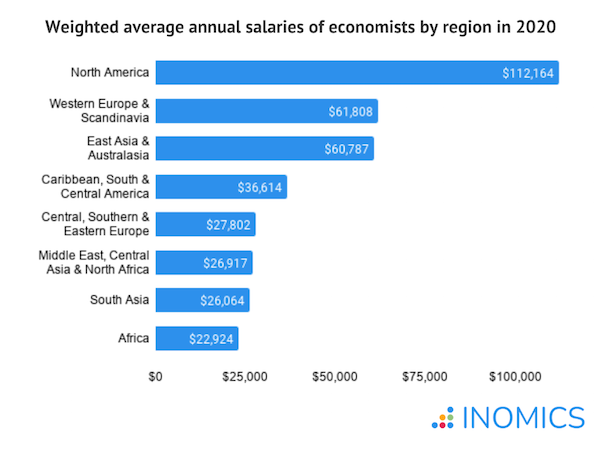The following article is an analysis of data taken from the INOMICS Salary Report 2020/21 – which is available to download in full here. Specifically, this article looks at the average salaries of economists around the world working in academia, the public sector and the private sector. It is the first instalment in a series of insights handling the Report’s findings.
Economists are – unsurprisingly – methodical about their careers, it’s in their nature. With every choice, and at every stage, the costs and benefits of decisions are meticulously weighed, the potential utility assessed. Here at INOMICS we know this better than most, helping, as we do, economists of all stripes through the process. We know which questions they seek to answer before choosing one career path over another. And always close to the top of the list – which, true to stereotype, is a lengthy one – is where in the world do economists earn the most?
With salary data from respondents based in 128 countries, INOMICS’ recently released Salary Report answers this query, along with many others pertaining to economists’ salaries within and across regions. Among its most shocking findings, the report exposes the regional inequality in salaries. While the hierarchy itself may not be entirely surprising, the gulf between regions is so stark, and the disparities so great, it’s simply not possible to talk of a single global job market for economists – the geographical divergences in wages are too substantial.
 As the graph shows, North America is far and away the most lucrative job market for economists, the average annual salary standing at an eye-watering $112,164. Economists based in North America earn, on average, almost twice as much as their colleagues in the next most lucrative markets in Western Europe & Scandinavia and East Asia & Australasia, where average salaries stand at 61,108 and 60,787 respectively, and nearly five-times those in Africa and South Asia. This superiority of wages exists across all sectors, and although the cost of living is often more expensive, in terms of pure dollars and cents, the region is unrivalled. Truly, if the size of your pay packet is your greatest concern, it’s the only place to work.
As the graph shows, North America is far and away the most lucrative job market for economists, the average annual salary standing at an eye-watering $112,164. Economists based in North America earn, on average, almost twice as much as their colleagues in the next most lucrative markets in Western Europe & Scandinavia and East Asia & Australasia, where average salaries stand at 61,108 and 60,787 respectively, and nearly five-times those in Africa and South Asia. This superiority of wages exists across all sectors, and although the cost of living is often more expensive, in terms of pure dollars and cents, the region is unrivalled. Truly, if the size of your pay packet is your greatest concern, it’s the only place to work.
Delving a little deeper into the region’s data, further details also become clear: US wages are dragging up the region’s average. Wages in the US vastly outstrip those in Canada, which are themselves among the highest in the world, a difference that is most pronounced in industry and the public sector, where those occupying senior management positions earn an enormous $190,000 on average, exactly double that of their Canadian colleagues. That the highest wages in North America are found outside academia is not unusual, INOMICS data from other regions – most notably Western Europe and Scandinavia – shows a similar distribution.
The regional inequality these data expose have long existed, as previous Salary Reports can attest. And they seem unlikely to shift. Indeed, this year’s Report reveals the stark difference in how the coronavirus pandemic has been experienced across the world, entrenching and exacerbating these divisions. Both our data, and the personal testimonies the Report also includes, show the extent to which economists working in the Global South have suffered far higher levels of job loss, greater reductions in working hours and salary, and have had more promotions postponed. Future insights will investigate in more detail the data surrounding these disturbing developments.
To view our methodology and how we calculated the figures used in this article, please see the full INOMICS Salary Report 2020/21.














